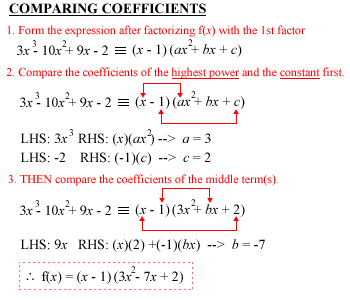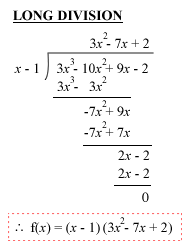
to her previously-rebonded hair
One more time …
*Puts on helmet*
*SHOWS STERN & MEAN & TIRED FACE*
*Sounds bugle* EVERYBODY FALL IN!
Most of you would’ve started your Mid-Year Exams by now – a series of no-holds-barred trials to determine once and for all if indeed a wind tunnel exists between your ears to test your understanding of topics taught in Semester 1.
For some, this could also be a time for your ‘chers to avenge all the tortures you’ve subjected them to throughout the term. As such, the Mids always tend to be a little on the sadistic side, and strewn with devious tricks around every turn and corner.
That’s why Miss Sergeant Loi (whose Teresa Teng voice is now hoarse from all the shouting) is here – to hopefully help save you a mark or two, to give you that little bit of edge from being pwned by your ‘chers.
So let’s do this one more time (to complete the chapter on Polynomials) … for now …
Remainder & Factor Theorems
A. REMAINDER THEOREM
e.g. Find the remainder when 4x3 – 5x + 1 is divided by:
i. x-2, ii. x+3, iii. 2x-1
Ans: Let f(x) = 4x3 – 5x + 1. Remainder, R =
- f(2) = 4(2)3-5(2)+1 = 23
- f(-3) = 4(-3)3-5(-3)+1 = -92
→ note it’s divided by x (+) 3 so you’re have to sub in (-)3 instead - f(½) = 4(½)3-5(½)+1 = -1
→ note when divided by (2x-1) → you’ll have to convert it to the form (x-½) first and then sub in the ½
 DON’T waste time doing long division in remainder theorem questions!!!
DON’T waste time doing long division in remainder theorem questions!!!
B. FACTOR THEOREM
⇒ (x – a) is a factor of f(x)
⇒ f(x) is exactly divisible by (x – a)
From your Sec Two Expansion & Factorisation chapter:
- Expansion → remove brackets
- Factorisation → put back brackets ⇒ final answer must always be in brackets!
e.g. Factorise x2 – 5x + 6
Ans via Trial & Error (try getting this under 10 sec 😀 ):
Choose 2 factors of the constant 6
try: 1 x 6 → 1x + 6x ≠ -5x (reject)
try: 2 x 3 → 2x + 3x ≠ -5x (reject)
try: (-2) x (-3) → -2x + (-3)x = -5x (YAY!)
⇒ cross-check: f(3) = f(2) = 0 (YAY!)
⇒ x2 – 5x + 6 = (x – 3)(x – 2)
 When you see the keyword Factorise, final answer must be in (brackets) i.e. don’t try to be funny and write x = 3, 2 → minus marks!
When you see the keyword Factorise, final answer must be in (brackets) i.e. don’t try to be funny and write x = 3, 2 → minus marks!
C. SOLUTION OF EQUATIONS
When you spot the keywords Solve and/or = 0 in your exam question, it means you’ll normally have to:
- Find the factors of an equation f(x) (usually cubic)
- Find the roots of f(x)=0 (i.e. final answer must be in the form: x = a, b … where a, b, … are the roots)
e.g. Solve 3x3 – 10x2 + 9x – 2 = 0
Ans: Let f(x) = 3x3 – 10x2 + 9x – 2.
- Find the first factor via trial and error
Try x=1: f(1) = 3(1)3 – 10(1)2 + 9(1) – 2 = 0 (YAY!)
⇒ (x-1) is a factor - Find the remainder expression by either COMPARING COEFFICIENTS:

OR LONG DIVISION (if you’re a long division aficionado)

You should get the SAME expression either way – use which ever method you’re more comfortable with (use one method to cross check the other if you’re one of those with lotsa free time left in your exam).
- Factorize the remaining quadratic expression 3x2-7x+2 (via quick Trial and Error method described in B above):
Choose 2 factors of the constant 2
try: (-2) x (-1) → (3)(-2)x + (-1)x = -7x (YAY!)
→ Note the coefficient of 3 of the x2 term
⇒ 3x2 – 7x + 2 = (3x – 1)(x – 2)
→ Note it’s NOT (3x – 2)(x – 1) coz you need to corss-multiply
⇒ cross-check: f(⅓) = f(2) = 0 (YAY!)⇒ 3x3 – 10x2 + 9x – 2 = (x-1)(3x-1)(x-2) = 0
⇒ x = 1, 2, ⅓
 When you see the keywords Solve and/or = 0, final answer must be in the form x = a, b … i.e. don’t stop at factorising → minus marks!
When you see the keywords Solve and/or = 0, final answer must be in the form x = a, b … i.e. don’t stop at factorising → minus marks!
 Sometimes the quadratic equation in Step 3 cannot be easily factorised → you’ll have to use the Quadratic Formula to find the two solutions. You’ll normally get the hint when you see terms like ±√ within the question.
Sometimes the quadratic equation in Step 3 cannot be easily factorised → you’ll have to use the Quadratic Formula to find the two solutions. You’ll normally get the hint when you see terms like ±√ within the question.
SAMPLE PRACTICE QUESTION
The cubic polynomial f(x) is such that the coefficient of x3 is -1 and the roots of the equation f(x) = 0 are 1, 2 and k. Given that f(x) has a remainder of 8 when divided by x-3, find
- the value of k,
- the remainder when f(x) is divided by x+3
Ans:
Since 1, 2 and k are roots, a(x-1)(x-2)(x–k) = 0
→ straightaway write down in factorized form once roots are known
→ always remember to include the coefficient a for x3 for it may not always be 1!
And since coefficient of x3 = -1
⇒ a = -1
⇒ (-1)(x-1)(x-2)(x–k) = 0
Let f(x) = (-1)(x-1)(x-2)(x–k)
- Since remainder is 8 when divided by (x-3),
f(3) = (-1)(3-1)(3-2)(3-k) = 8
(using Remainder Theorem from A above)
⇒ k = 7 - Now using k = 7 above, f(x) = (-1)(x-1)(x-2)(x–7)
Remainder when divided by x+3:
→ f(-3) = (-1)((-3)-1)((-3)-2)((-3)-7) = 200
*For some reason, students have a habit of expanding the entire expression after they’ve written down everything in factorized form = what a waste of time. Tsk.
As always, get these rules drilled into your head! Spot the pointers and common mistakes in red! Understand the representative sample question! Check out further questions on factor theorem!
Print this out if necessary and remember the above procedures by heart … and do let Miss Loi know which topics and stuffs you would like to see in her next set of Maths Notes 😉
Till then, understand that the ultimate root of your own equation is to prepare youself in mind and in soul for the Great War at year’s end. So don’t be afraid to make all the mistakes you need to make now (as long as you know what mistakes you’re making!).



 Miss Loi is a full-time private tutor in Singapore specializing in O-Level Maths tuition. Her life’s calling is to eradicate the terrifying LMBFH Syndrome off the face of this planet. For over years she has been a savior to countless students …
Miss Loi is a full-time private tutor in Singapore specializing in O-Level Maths tuition. Her life’s calling is to eradicate the terrifying LMBFH Syndrome off the face of this planet. For over years she has been a savior to countless students … 




















